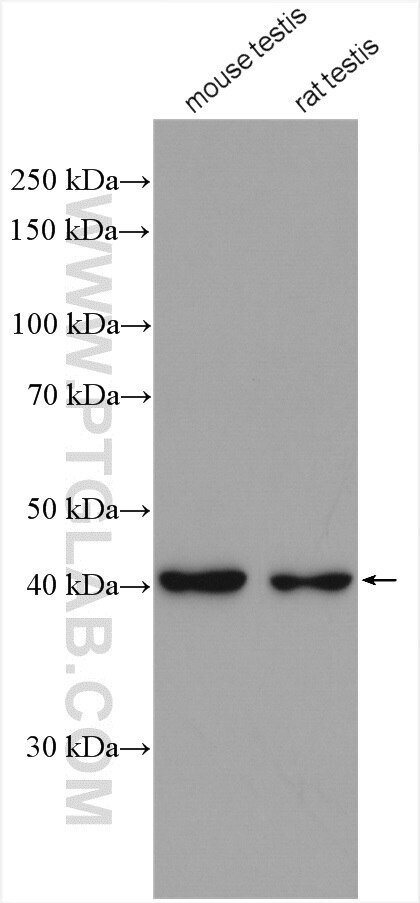ACTRT2 Polyklonaler Antikörper
ACTRT2 Polyklonal Antikörper für WB, ELISA
Wirt / Isotyp
Kaninchen / IgG
Getestete Reaktivität
human, Maus, Ratte
Anwendung
WB, CoIP, ELISA
Konjugation
Unkonjugiert
Kat-Nr. : 16992-1-AP
Synonyme
Galerie der Validierungsdaten
Geprüfte Anwendungen
| Erfolgreiche Detektion in WB | Maushodengewebe, Rattenhodengewebe |
Empfohlene Verdünnung
| Anwendung | Verdünnung |
|---|---|
| Western Blot (WB) | WB : 1:500-1:2000 |
| It is recommended that this reagent should be titrated in each testing system to obtain optimal results. | |
| Sample-dependent, check data in validation data gallery | |
Veröffentlichte Anwendungen
| WB | See 1 publications below |
| CoIP | See 1 publications below |
Produktinformation
16992-1-AP bindet in WB, CoIP, ELISA ACTRT2 und zeigt Reaktivität mit human, Maus, Ratten
| Getestete Reaktivität | human, Maus, Ratte |
| In Publikationen genannte Reaktivität | human, Maus |
| Wirt / Isotyp | Kaninchen / IgG |
| Klonalität | Polyklonal |
| Typ | Antikörper |
| Immunogen | ACTRT2 fusion protein Ag10597 |
| Vollständiger Name | actin-related protein T2 |
| Berechnetes Molekulargewicht | 376 aa, 42 kDa |
| Beobachtetes Molekulargewicht | 40-42 kDa |
| GenBank-Zugangsnummer | BC029499 |
| Gene symbol | ACTRT2 |
| Gene ID (NCBI) | 140625 |
| Konjugation | Unkonjugiert |
| Form | Liquid |
| Reinigungsmethode | Antigen-Affinitätsreinigung |
| Lagerungspuffer | PBS mit 0.02% Natriumazid und 50% Glycerin pH 7.3. |
| Lagerungsbedingungen | Bei -20°C lagern. Nach dem Versand ein Jahr lang stabil Aliquotieren ist bei -20oC Lagerung nicht notwendig. 20ul Größen enthalten 0,1% BSA. |
Protokolle
| Produktspezifische Protokolle | |
|---|---|
| WB protocol for ACTRT2 antibody 16992-1-AP | Protokoll herunterladen |
| Standard-Protokolle | |
|---|---|
| Klicken Sie hier, um unsere Standardprotokolle anzuzeigen |
Publikationen
| Species | Application | Title |
|---|---|---|
Development Loss of perinuclear theca ACTRT1 causes acrosome detachment and severe male subfertility in mice. | ||
Cell Rep The perinuclear theca protein Calicin helps shape the sperm head and maintain the nuclear structure in mice. |


